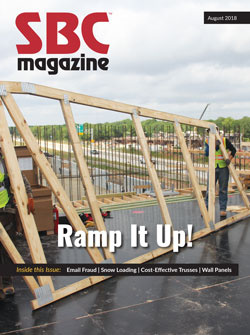President's Message: How Long is Too Long?
President's Message: How Long is Too Long?
Customers can ask tricky questions sometimes. A few months back, one of them requested we produce trusses for a job only to put the project on hold before we shipped them. Those trusses sat in our yard for a couple months before the customer was finally ready for them. He finally called me up a few weeks ago and asked if those trusses were still good to install.
Our plant is just outside Atlanta, and even if you’ve never been to Georgia you can probably imagine the type of weather they were exposed to while they sat. I didn’t know what to say to him. I suspected they were just fine, but I told him he needed to make the call. We took several pictures and encouraged him to come and look at the trusses in person. At the end of the day, I wanted to make sure if we went ahead and delivered them he wouldn’t just end up sending them back.
This certainly isn’t the only time we’ve manufactured trusses and then had to store them in the yard. It’s typically the customer’s fault, but not always. Sometimes we’ll accidentally build an A elevation when they wanted a B elevation. They’ll eventually want that A elevation, so we let them sit. Other times, the project gets delayed after delivery and the trusses sit on the jobsite for a while. I suspect most component manufacturers (CMs) have had similar experiences.
Whatever the reason for the delayed installation, our industry doesn’t currently have enough data to point us toward a definitive best practice when it comes to the effects nature and prolonged exposure to the elements have on trusses. That’s why SBCA is undertaking an initiative to expose trusses to a variety of weather conditions and then subject them to structural testing at our testing facility, SBCRI.
The goal is to measure the performance of identical trusses exposed to the weather (and 2x10s for comparison purposes) against a control set of trusses (and 2x10s) built at the same time but stored in a climate-controlled environment.
All of the trusses will be manufactured from the same truss design, using the same truss plates and the same lumber grades (both SYP and SPF will be tested). SBCRI will be working with individual SBCA members in the South, Northeast and West to expose the trusses to various conditions.
Once the exposure period is complete, the trusses will all be shipped to SBCRI and will be subjected to design load testing to measure weather exposure impacts on both truss stiffness, creep deformation and ultimate strength compared against the control trusses kept out of the weather.
A great group of really smart SBCA members and staff have been working hard to pull this test plan together and get it running. The results should allow us to create better guidance to CMs and their customers on how long and under what conditions trusses can be stored without it impacting their structural performance. This guidance will then be incorporated into SBCA’s in-plant quality control and TPI/SBCRI ISO/IEC 17020 quality assurance program.

